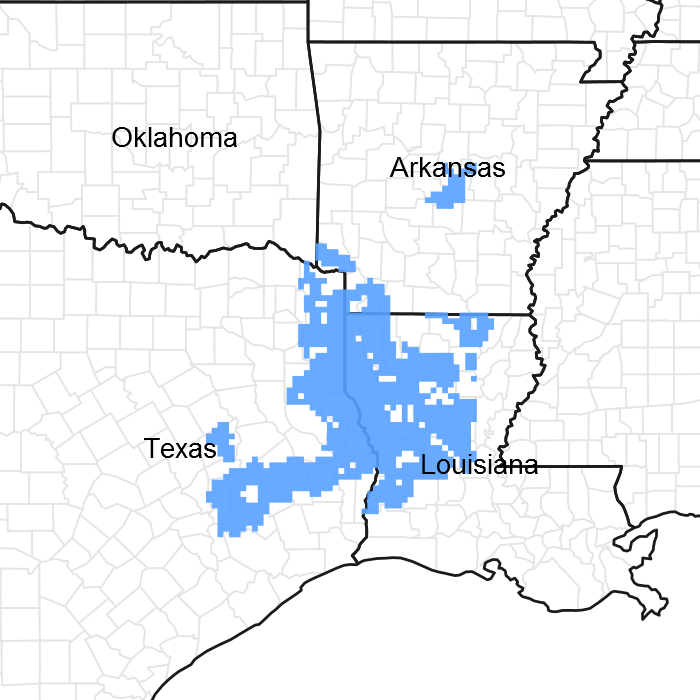
Natural Resources
Conservation Service
Ecological site F133BY002TX
Seasonally Wet Upland
Last updated: 9/21/2023
Accessed: 12/21/2025
General information
Provisional. A provisional ecological site description has undergone quality control and quality assurance review. It contains a working state and transition model and enough information to identify the ecological site.

Figure 1. Mapped extent
Areas shown in blue indicate the maximum mapped extent of this ecological site. Other ecological sites likely occur within the highlighted areas. It is also possible for this ecological site to occur outside of highlighted areas if detailed soil survey has not been completed or recently updated.
MLRA notes
Major Land Resource Area (MLRA): 133B–Western Coastal Plain
Major Land Resource Area (MLRA) 133B, Western Coastal Plain is in eastern Texas, western Louisiana, and the southwest corner of Arkansas. The area is dominated by coniferous forest covering 45,450 square miles (29,088,000 acres). The region is a hugely diverse transition zone between the eastern deciduous forests and the central grasslands to the west.
Classification relationships
USDA-Natural Resources Conservation Service, 2006.
-Major Land Resource Area (MLRA) 133B
Ecological site concept
The Seasonally Wet Upland site is unique by its upland position on the landscape, while also having a seasonally high water table. Clay soils in the subhorizons cause water to stay in the profile for long periods of time, especially from November to May. Not only does the water table affect the plants, but many of the soils are shallow with their depth to bedrock as low as 16 inches.
Associated sites
| F133BY005TX |
Loamy Upland Soils have a loamy texture throughout and a better drainage system. |
|---|---|
| F133BY001TX |
Depression Landform is lower and sites are wetter. |
| F133BY003TX |
Loamy Over Clayey Upland Landform is higher and sites have better drainage patterns. |
| F133BY004TX |
Loamy Claypan Upland Sites are very similar. Soils have a slightly better drainage system, typically moderately well or well drained as opposed to poorly drained. |
| F133BY012TX |
Wet Terrace Landform is lower, in the terrace position. |
| F133BY013TX |
Terrace Landform is lower, in the terrace position and sites have better drainage. |
Similar sites
| F133BY012TX |
Wet Terrace Sites are on a lower landform in the terrace position. |
|---|---|
| F133BY004TX |
Loamy Claypan Upland Sites are very similar, but have better drainage patterns. Sites are moderately well to well drained. |
Table 1. Dominant plant species
| Tree |
(1) Pinus taeda |
|---|---|
| Shrub |
Not specified |
| Herbaceous |
Not specified |
Click on box and path labels to scroll to the respective text.
Ecosystem states
| T1A | - | Fire suppression, no management |
|---|---|---|
| T1B | - | Clearcut, site preparation, tree planting |
| T1C | - | Clearcut, grass/crop planting |
| R2A | - | Selective timber harvest, prescribed burns |
| T2A | - | Clearcut, site preparation, tree planting |
| T2B | - | Clearcut, grass/crop planting |
| R3A | - | Gap-phase regeneration or clearcut with tree planting |
| T3A | - | Clearcut, no management |
| T3B | - | Clearcut, grass/crop planting |
| R4A | - | Tree planting, mid-story shrub control, prescribed burns |
| T4A | - | Fire suppression, no management |
| T4B | - | Clearcut, site preparation, tree planting |